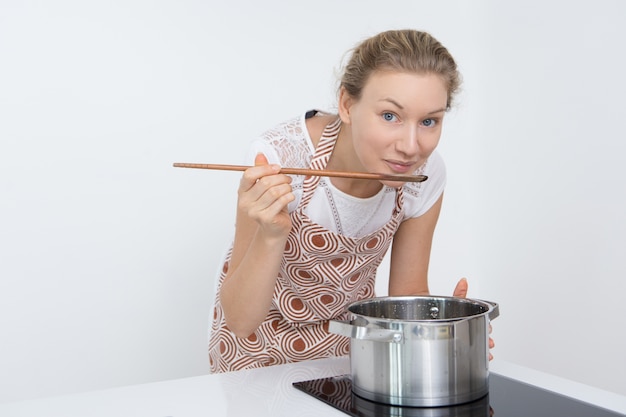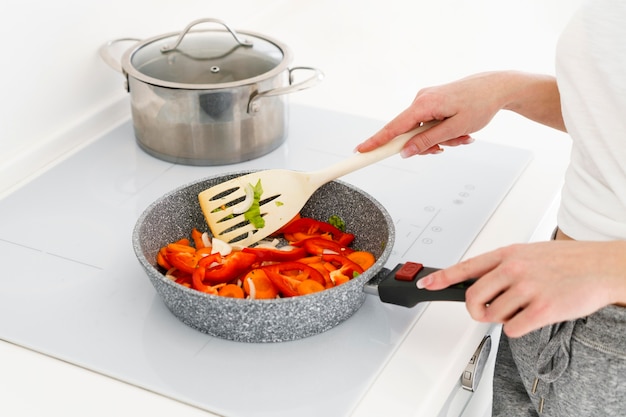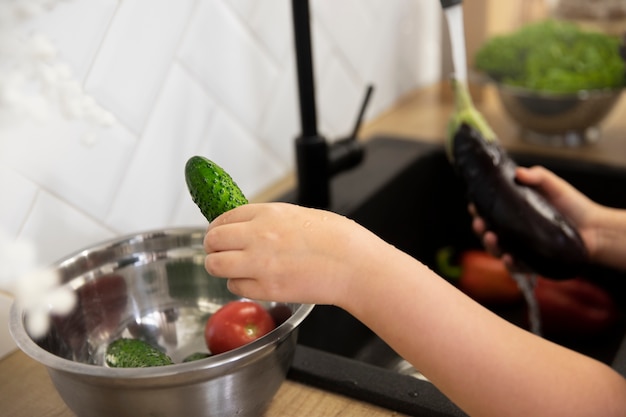(Part 1) choosing the right eggs: The Foundation of Perfection

The foundation of a great hard-boiled egg lies in selecting the right eggs. It’s like building a house – you need a solid foundation to ensure a strong and beautiful structure.
1. Size Matters: Big or Small?
Let’s talk about egg size. Larger eggs, with their extra yolk and white, will take a bit longer to cook through. So, if you're aiming for a firmer yolk, choose smaller eggs. But, if you prefer a more custardy texture, opt for those larger eggs. It's a matter of personal preference!
2. Fresh is Best: The “Float Test”
While you can definitely cook older eggs, they're more prone to cracking in the pot. To ensure you're working with fresh eggs, try the "float test". Simply fill a bowl with water and gently lower the egg in. If it sits flat on the bottom, it's fresh. If it stands up at a slight angle, it's about a week old. If it floats, it's time to toss it and grab a fresh one from the fridge!
3. Brown or White: A Matter of Personal Preference
Let’s clear up a common misconception: brown eggs and white eggs have the same flavour and texture. The colour difference is purely a matter of breed, not a reflection of taste or quality. So, pick whichever you prefer. I often go for brown eggs, just because they feel more rustic! It's all about that personal touch.
(Part 2) boiling eggs: The Basics of the Process

Now that you've chosen your perfect eggs, it’s time to get cooking. Let’s explore the crucial steps in boiling eggs to perfection.
1. Start Cold: The Secret to Avoiding a green ring
The most important rule to remember is to start with cold water. This might seem counterintuitive, but trust me, it's key! Starting with cold water allows the eggs to heat up slowly and evenly, preventing the yolk from developing that dreaded green ring around it. No one wants a green ring! It can make the eggs look unappetizing and slightly off-putting.
2. Add Salt: Preventing Cracks and Enhancing Flavor
Now, here's a trick I learned from my granny: add a tablespoon of salt to the water before bringing it to a boil. The salt does more than just add flavour to the water. It actually helps keep the eggs from cracking while they cook. The salt creates a more stable environment, making the eggs less susceptible to the pressure changes that can cause them to crack.
3. Bring to a Boil: Gentle Handling for Perfect Eggs
Once the water is boiling, gently lower the eggs into the pot using a slotted spoon. This gentle approach minimizes the risk of cracking. Let them settle at the bottom of the pot before you start timing. This allows them to heat up evenly and prevents them from sticking to the bottom of the pot.
(Part 3) Perfect Cooking Times: Achieving Your Desired Texture

Here's where things get really interesting – the cooking times. This is the crux of the matter, the key to unlocking that perfectly cooked egg. I've tested these times myself, and trust me, they're accurate, but remember, every egg is slightly different, so adjust based on your preference.
| egg texture | Cooking Time |
|---|---|
| Soft-Boiled (runny yolk) | 3-4 minutes |
| Medium-Boiled (Slightly Runny Yolk) | 5-6 minutes |
| Hard-Boiled (Set Yolk) | 7-8 minutes |
| Very Hard-Boiled (Firm Yolk) | 9-10 minutes |
Remember, these are just guidelines. The size of your eggs and the altitude you're cooking at can affect the cooking time. So, if you're unsure, start with the shorter end of the range and check your eggs early. It's better to err on the side of undercooked than overcooked, because you can always cook them a little longer.
(Part 4) The Cooling Process: The Secret to Smooth Peeling
Your eggs are cooked! Now, this is where many people go wrong. Proper cooling is just as important as the cooking process. It's the finishing touch that makes all the difference.
1. Ice Bath: Stopping the Cooking and Preventing Overcooked Yolk
The moment the eggs are done, immediately drain the hot water and plunge them into a bowl of ice water. This is the key to preventing that rubbery yolk. The ice water stops the cooking process and prevents the yolk from becoming overcooked. It also makes peeling much easier.
2. Chill Out: Solidifying the Yolk and White
Let the eggs sit in the ice water for at least 10-15 minutes, or until they are completely cool. This chilling process helps to solidify the yolk and white, making them easier to peel and enhancing the overall texture. The colder the eggs, the easier they will be to peel.
(Part 5) Peeling Perfection: Mastering the Art of Effortless Peeling
We’ve all been there: trying to peel hard-boiled eggs and ending up with a mess of tiny shell fragments stuck to the white. But it doesn't have to be a nightmare. Follow these tips and peeling will become a breeze!
1. The Right Technique: Gentle Tapping and Rolling
First, gently tap the egg all over to crack the shell. Start peeling from the wider end, where the air pocket is. As you peel, gently roll the egg between your palms to loosen the shell. Don’t force it. Be patient, and the shell will come off in large pieces.
2. The Magic of Vinegar: Breaking Down Protein for Easy Peeling
Adding a tablespoon of vinegar to the boiling water can actually make peeling easier! The vinegar helps to break down the protein in the egg white, which makes the shell peel off more smoothly. It's a simple trick with a big impact.
3. Avoiding Cracking: Gentle Handling and Proper Spacing
To avoid cracking the egg while cooking, gently lower the eggs into the pot with a slotted spoon and don’t overcrowd the pot. Also, be careful not to bump the pot while the eggs are cooking. The more you jostle the pot, the more likely the eggs are to crack.
4. The Old-School Method: The Power of a Gentle Blow
For stubborn eggs, I often use my grandma's method. Just give the egg a firm, but gentle, blow on the wider end. It might sound weird, but it often helps loosen the shell. The air pressure from the blow creates a small pocket of air, which helps to separate the shell from the white.
(Part 6) Creative Ways to Use Hard-Boiled Eggs: Beyond the Basic
Let's be honest, hard-boiled eggs are more than just a simple snack! They're incredibly versatile and can be used in countless ways.
1. egg salad Sandwiches: A Classic Delight
A classic for a reason! Just chop up some hard-boiled eggs, mix them with mayonnaise, mustard, and your favourite seasonings, and pile it onto some fresh bread. You can get creative with your additions, like celery, onion, or even a dash of paprika.
2. deviled eggs: A Party Favourite
Deviled eggs are a party staple, and for good reason! Hard-boiled eggs are the base for these delicious bite-sized treats. Just halve them, scoop out the yolk, mash it with mayonnaise, mustard, and seasonings, and pipe the mixture back into the egg whites. You can also add other ingredients like chopped gherkins, chopped green onions, or a sprinkle of smoked paprika for extra flavour.
3. Salads: A Protein Punch
Hard-boiled eggs add a protein punch to any salad. Chop them up and toss them into a green salad, or use them as a topping for a more substantial salad with quinoa, chickpeas, or lentils. They also add a great texture and richness to salads.
4. Breakfast Bowls: A Hearty Start to the Day
Start your day with a protein-packed breakfast bowl. Top yoghurt, granola, or oatmeal with chopped hard-boiled eggs, and you’re good to go. They add a satisfyingly savoury element to your breakfast, making it a complete meal.
5. Snacks: Simple and Satisfying
Of course, don't forget the simple pleasures of a plain hard-boiled egg! It's a perfect snack on the go or a quick and easy meal when you’re short on time. They’re a great source of protein and nutrients, making them a healthy and convenient choice.
(Part 7) Storage and Shelf Life: Keeping Your Eggs Fresh
Once you’ve cooked your perfect hard-boiled eggs, you’ll want to store them properly to ensure they stay fresh and delicious. Proper storage is crucial to maintaining their quality and flavour.
1. Refrigerate: Keeping Them Fresh and Ready to Eat
Hard-boiled eggs should be stored in the refrigerator, ideally in a sealed container or bag to prevent them from drying out. They’ll last for about a week in the fridge. Keep them in the coldest part of the fridge, away from strong odours.
2. Freezing: A Longer Shelf Life, but with a Slight Texture Change
You can freeze hard-boiled eggs, but they might lose a little bit of their texture. If you do freeze them, peel them first, then store them in a freezer-safe bag. They can last for about 3 months in the freezer. However, they will be slightly softer than fresh hard-boiled eggs.
(Part 8) FAQs: The Answers to Your Most Burning Questions
Ready for some answers? Here are some of the most common questions about hard-boiled eggs.
1. Why do hard-boiled eggs get a green ring around the yolk?
The green ring is caused by a chemical reaction that happens when the eggs are overcooked. The iron in the yolk reacts with hydrogen sulfide in the egg white, creating iron sulfide, which gives the yolk its green tinge. To prevent this, cook the eggs for a shorter time or start with cold water. This allows the eggs to heat up more evenly, reducing the likelihood of the green ring.
2. Why do hard-boiled eggs crack when cooking?
Eggs can crack for a few reasons: they could be old, the water might be too hot, or they might be overcrowded in the pot. To prevent cracking, use fresh eggs, add a tablespoon of salt to the water, start with cold water, and gently lower the eggs into the pot using a slotted spoon. These steps create a more stable environment for the eggs, making them less prone to cracking.
3. Can I use brown eggs instead of white eggs?
Absolutely! Brown eggs and white eggs have the same flavour and texture, so pick whichever you prefer. The color is purely a matter of the chicken breed, not a reflection of taste or quality.
4. How can I tell if a hard-boiled egg is fresh?
You can do the “float test”: Fill a bowl with water and gently lower the egg in. If it sits flat on the bottom, it's fresh. If it stands up at a slight angle, it's about a week old. If it floats, it's time to toss it. The float test is a simple and reliable way to gauge the freshness of your eggs.
5. What’s the best way to peel hard-boiled eggs?
Tap the egg all over to crack the shell, start peeling from the wider end, and gently roll the egg between your palms to loosen the shell. You can also add a tablespoon of vinegar to the boiling water to make peeling easier. These techniques help to separate the shell from the white, making peeling a much smoother process.
And there you have it! My comprehensive guide to the perfect hard-boiled egg. Now, go forth and conquer the world of egg-cellent breakfasts, snacks, and salads! Happy cooking!
Everyone is watching

How to Cook Frozen Lobster Tails Perfectly: A Step-by-Step Guide
RecipesLobster. Just the word conjures up images of lavish meals, special occasions, and a taste of luxury. But let's...

Pigs in a Blanket Cooking Time: How Long to Bake for Perfect Results
RecipesAh, pigs in a blanket. Just the name conjures up images of those delightful little parcels of crispy pastry en...

Pork Fillet Cooking Time: How Long to Cook It Perfectly
RecipesPork fillet, or tenderloin as it's sometimes called, is a real favourite in our house. It's so versatile, and...

The Ultimate Guide to Cooking Delicious Frankfurters
RecipesLet's face it, we all love a good frankfurter. It's a classic, simple, and always satisfying. But let's be rea...

The Ultimate Guide to Tender, Juicy Pulled Pork
RecipesRight, let's talk pulled pork. It's one of those dishes that just screams "comfort food," doesn't it? I mean...
